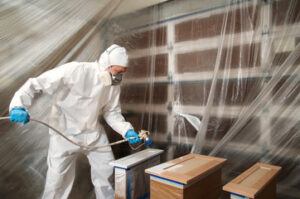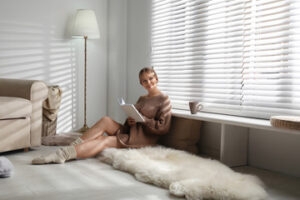Refacing is an ideal solution to refresh your kitchen’s aesthetic, without the cost and hassle of complete cabinet replacement. Refacing provides the option to change door style, color, and hardware for an instant improvement.

Solid wood is a popular material for cabinet refacing because of its natural appearance and durability. However, it can warp due to humidity or temperature changes if not properly maintained. Contact Cabinet Refacing Sacramento CA for professional help.
Cabinet refacing can take your outdated or unattractive cabinets and transform them into something beautiful that you’ll be proud to show off. It’s also an effective way to make changes without going through a kitchen remodel that’s disruptive, messy and all-consuming. It’s also more cost-effective than replacing the cabinets altogether.
Wood cabinet refacing offers elegance and flexibility to match any kitchen style. From traditional to contemporary, a wide range of wood options is available in rich hues and authentic grains. Stained solid wood is durable, resists and hides scratches, and can be refinished in the future. It’s also resistant to humidity and heat.
PVC vinyl is an affordable, low-maintenance choice that replicates the look of natural wood. It’s available in a variety of colors and is easy to clean, but it can be scratched and dented and is not very heat resistant. It can also be susceptible to delamination and peeling if not properly cared for.
Laminate is a good alternative to melamine and provides a high-quality, attractive, and inexpensive option that’s easy to maintain. It’s not as durable as solid wood, but it resists stains and scratches. Like other refacing materials, laminate requires regular cleaning with mild soap and water and some preventive steps to protect against heat and humidity.
Metal refacing is another popular choice that’s durable and attractive. It’s also easier to reface than other materials because the face-frames and drawer fronts are attached to their existing boxes. To install them, the existing cabinets must be cleaned and lightly sanded to create a rough surface for the adhesive. You must use a high-quality adhesive designed for metal surfaces to ensure it adheres properly.
PVC Vinyl
A popular cabinet refacing material, PVC vinyl is an affordable option that can give your cabinets a sleek, modern look. It’s also highly durable and easy to clean, making it a great choice for homes with children or pets. PVC vinyl is available in a variety of colors and finishes, so you can find the perfect fit for your home.
This type of refacing involves applying a vinyl laminate over the existing cabinet boxes. It’s a less invasive option than a full renovation, but it still requires careful attention to detail. This is because the surface of the cabinet box is exposed, so it needs to be protected from moisture and other environmental factors.
Thermofoil, a PVC (polyvinyl chloride) film, is vacuum-sealed over medium-density fiberboard (MDF) and bonded under heat and pressure. The result is a smooth finish that mimics the appearance of natural wood. It’s an affordable, low-maintenance alternative to wood veneers that’s ideal for high-traffic areas.
Cabinet refacing can be completed in a fraction of the time it takes for a complete kitchen renovation, and it can save you up to 80% compared to the cost of buying and installing new cabinetry. However, refacing doesn’t address workflow or storage issues and may not improve the overall functionality of your kitchen.
To ensure a long-lasting, high-quality finish, it’s important to choose quality materials. A good contractor will offer a wide selection of designs and styles to suit your taste and budget, as well as provide expert advice on the best options for your home. They’ll also be able to advise you on the installation process and any other additional costs involved. You’ll need to prepare the surfaces for application by cleaning them thoroughly with degreasing agents and mild detergents, and you’ll need some basic tools to complete the job, including a squeegee or smoothing tool for expulsion of air bubbles and to ensure even adhesion.
Wood Veneers
Many woodworkers use wood veneers, and they can be very high quality. Some people are under the impression that veneers are cheap or low quality, but this is simply not the case. It takes a lot of skill, knowledge and experience to produce high-quality veneers. There are many benefits to using wood veneers in cabinetry.
Because wood veneer uses only a thin layer of natural wood, it is much more durable than solid wood and less prone to warping. It also costs less than solid wood. It is also more versatile and comes in a wide variety of colors and grain patterns, giving homeowners design and style flexibility. In addition, wood veneer is easier to work with than solid wood, and it can be cut into a shape or curve that would be difficult with solid wood.
Another benefit of wood veneer is that it is sustainable. Because a single log can be used to create multiple layers of wood, it results in less waste and helps to conserve resources. In addition, using wood veneer allows designers to use species that might be very expensive if used in solid wood.
It is important for architects to provide detailed wood veneer specifications in order to avoid problems later in the project. Otherwise, the sequencing of veneer panels may not be consistent and it can result in a jarring visual effect.
It is also important to know that when working with wood veneer, you should only use glues specifically designed for this type of work. Other glues, such as yellow glue or carpenter’s glue, can cause the veneer to move over time. This can be a major problem, especially in humid areas.
3D Laminate
A contemporary style option for cabinet refacing, 3D laminate creates consistent, seamless appearances that are difficult to achieve with painted cabinets. Designed to mimic premium materials such as wood grain and marble, these durable materials are a cost-effective alternative to full replacement that’s easy to clean.
Available in a wide range of colors and textures, 3D laminate cabinet refacing transforms both the interior and exterior of your existing cabinets to match your new design scheme. This streamlined process is less expensive and quicker than a complete kitchen remodel. It also minimizes waste by reusing your existing cabinet boxes while providing an aesthetic upgrade.
This refacing material combines medium-density fiberboard (MDF) with vinyl to create a smooth surface that’s easy to clean and more affordable than paint or natural wood. MDF is more stable than particleboard, making it resistant to warping and moisture. This refacing product has a pressure-sensitive adhesive that allows it to be installed without nails, reducing the risk of peeling. It’s ideal for refacing face frames and larger surfaces, such as cabinet drawer fronts and knick-knack shelves.
High-gloss laminates are a modern choice for bathroom and kitchen cabinet refacing projects because they’re visually appealing, durable and easy to clean. Their reflective surface enhances natural light, promoting brightness and spaciousness in your home’s living spaces. They’re also non-porous and stain-resistant, providing a hygiene benefit in areas of the home where cleaning is most frequent.
With a wide variety of styles and finishes to choose from, refacing can help you make your home’s kitchen or bath into the space you’ve always dreamed of. Refacing can be completed in days versus the weeks that a full renovation would take, and it’s environmentally friendly by reusing your existing cabinets.
Rigid Thermofoil
Cabinet refacing is a much less expensive and more non-invasive option than a complete remodel. It allows you to update the look of your kitchen and bathroom without altering their layout or removing existing cabinets. However, it’s important to consider all aspects of cabinet refacing before deciding whether it is the best solution for you.
While the cost of cabinet refacing is less than that of a full remodel, it is not as affordable as buying new cabinets. Additionally, refacing isn’t suitable for all types of cabinetry. For example, refacing isn’t recommended for resurfacing cabinet boxes that are damaged or warped. If your cabinet boxes are sagging or warped, it would be better to invest in a full remodel to ensure your new doors and drawer fronts attach properly.
Rigid thermofoil (RTF) is a composite material consisting of an MDF or particle board substrate with layers of flexible vinyl bonded under heat and pressure. These layers can be molded to mimic the appearance of wood grain, solid color, or other design elements. These surfaces are durable and resistant to moisture, but can peel if exposed to extreme temperatures.
Thermofoil cabinet refacing is a great choice for those with a limited budget who want to achieve a polished look. It’s also ideal for homeowners who prefer a low-maintenance option that is easy to clean. Nonetheless, Thermofoil can lack the authenticity and warmth of natural wood grain, and it may not be ideal for those who are sensitive to environmental concerns. It can also be susceptible to delamination, in which the vinyl coating separates from the MDF or particle board substrate due to environmental factors or manufacturing defects.
